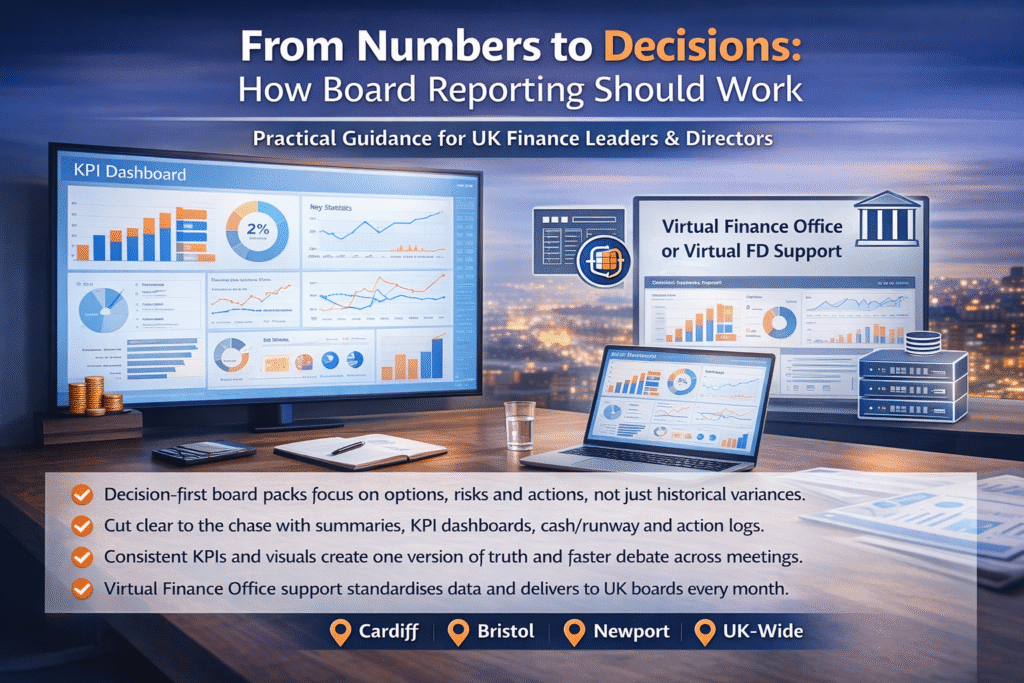Key Takeaways of the Case study:
- One coordinated launch plan covered entity setup, governance, tax, and operations for several limited companies.
- Xero built end to end with bank feeds, rules, approvals, fixed-asset registers, VAT checks, and a simple monthly close.
- £25,000 match funding secured with a lender-ready narrative, three-way forecasts, and evidence.
- Tax savings delivered via tighter expense capture, capital-allowance planning, and VAT accuracy.
- Scalable reporting installed: KPI dashboards, rolling cash flow, and concise board packs.
- Virtual Finance Director cadence keeps decisions, forecasts, and execution aligned.
Who is Rupali and what was the brief?
Rupali is a qualified bookkeeper-accountant who was launching her own practice while co-running several hospitality companies; she asked for a partner to build clean finance systems, keep filings right the first time, and secure growth funding. She wanted everything to work together, not as silos. She wanted simple daily operations, credible monthly numbers, and materials a lender can trust. We agreed on a single operating model that multiple companies could copy with minor tweaks.
Why this matters for readers: Teams that split bookkeeping, tax, and planning across uncoordinated vendors lose time and control. The cost shows up as late payments, VAT mistakes, and slow month-end. UK small businesses are already squeezed by late payers—in Q2 2024 invoices were paid 7.3 days late on average, with hospitality among the hardest hit—so tight finance rhythms are not “nice to have”, they are cash protection. (Source: Xero Small Business Insights.)
What problems were we solving?
We solved four problems at once: parallel launches, scattered processes, uncertain tax treatment, and a funding gap.
If any one of these runs alone, it drags the others down. So we used one playbook so that entity setup, Xero workflows, tax handling, and funding materials moved in step. The result was speed without chaos and controls without friction.
- Multiple launches: Different legal entities and revenue models needed shared standards and local tracking.
- Scattered processes: Unclear ownership and ad-hoc tools made bookkeeping slow and reporting uneven.
- Tax uncertainty: Early-stage errors compound; HMRC’s own figures show small businesses now account for ~60% of the UK tax gap, with error and failure-to-take-reasonable-care significant factors. (Source: HMRC Measuring Tax Gaps 2023/24; FT analysis.)
Funding gap: Lenders and grant bodies fund plans, not wishes. We needed three-way forecasts, sensitivity cases, and evidence to unlock support.

How did we structure launch support across multiple companies?
We used a repeatable playbook: one plan, clear owners, a short manual, and a month-end rhythm.
This kept the experience consistent for staff and consistent for lenders.
- Entity setup and governance
We confirmed share structures, directors, and responsibilities, then issued a one-page finance manual covering spending limits, receipt rules, month-end dates, and approval routes. Teams use this on day one. Directors sign it. No ambiguity. - Chart of accounts and tracking
We built a shared chart with tracking categories for sites and revenue streams (e.g., café vs. catering; dine-in vs. delivery). A single taxonomy allowed cross-company comparisons while preserving entity-level P&L for statutory needs. - Opening balances and cutover
We migrated bank, debtors, creditors, and fixed assets, then reconciled to the penny before go-live. Funders notice this discipline. Auditors do, too. - Month-end rhythm
We set a simple sequence: bank to 100% reconciliation, purchase review, payroll journals, VAT checks, management pack issued, commentary signed off. Public-sector guidance and professional practice both back monthly reconciliations because they reduce errors and clarify cash. (Including implementing a cash flow plan and building a system that protects from a cash runway) - People and training
We recorded 5-minute how-to videos, issued one-page checklists, and held office hours. The aim was independence, not dependency.
Why Xero, and what did end-to-end workflows include?
We chose Xero for speed, clarity, and integrations that fit hospitality and a growing practice.
If teams capture receipts fast and reconcile banks daily, cash and VAT stay accurate. If reviewers can see controls, month-end goes faster.
End-to-end build:
- Bank feeds and rules: Live feeds with rules that post routine entries automatically. Exceptions flagged for review.
- Sales and payments: Branded invoices, online payments enabled, automatic reminders. Debtor days improve when you match how customers actually pay; only 55% of UK small businesses offer consumers their preferred card methods, so enabling card options matters.
- Purchases and approvals: Threshold-based approvals and monthly supplier statement matches.
- Fixed assets and depreciation: Registers mapped to capital-allowance pools from day one, which matters at year-end.
- VAT accuracy: A pre-submission checklist catches common opening-month errors before they repeat.
- Month-end controls: Nil unreconciled, aged balances reviewed, journals posted, lock dates applied to protect prior periods.
- Management pack: One standard pack across companies—P&L with site tracking, cash flow, KPIs, two pages of commentary
How was £25,000 match funding secured?
We won £25,000 in match funding by combining a believable market story with three-way forecasts and an evidence pack.
Match funding means the awarding body expects you to put in money alongside the grant, so your plan must show uses of funds and milestones that attract co-finance.
The pack included:
- Market fit narrative: Proposition, target customers, and “why now” in one page.
- Three-way model (18–24 months): P&L, balance sheet, and cash flow, built from staffing plans, seating capacity, covers, and price points—the operational levers hospitality leaders actually manage.
- Sensitivity cases: Slower sales, higher input costs, and slipped timings. If margins tighten, we showed levers: menu mix, price steps, labour scheduling.
- Use of funds: Fit-out, hiring, opening stock, and marketing—each with a date and milestone.
- Evidence pack: Quotes, supplier terms, draft contracts—risk reduced on paper.
- Board summary: The ask, the return, and the protections—one page.

Where did the tax savings come from?
Tax savings came from housekeeping and structure, not gimmicks.
The biggest wins were allowable expense capture, capital-allowance planning, and VAT accuracy—the same areas HMRC highlights when it reports errors and “failure to take reasonable care”. (Source: HMRC Measuring Tax Gaps; KPMG summary; FT.
- Allowable expenses captured: Tight coding + receipt capture stopped leakage. Missed costs inflate profit and overstate Corporation Tax.
- Capital allowances planned: Registers mapped to main pool, special rate, and structures & buildings allowance classifications from day one so reliefs were not lost in general spend.
- VAT accuracy improved: A short pre-submission checklist reduced input VAT errors that creep into opening months.
Compound effect: Better coding this month trims tax next quarter and strengthens cash. When late payments are rising and sector margins are tight, even a 1–2 percentage point swing in net margin matters. Hospitality benchmarks show rooms and F&B carry very different revenue shares by region; tracking mix accurately is not academic, it’s pricing power.
What did scalable reporting look like?
Scalable reporting meant you can add a site, product, or company without rebuilding spreadsheets and you can understand performance at a glance.
We set the metrics, the cadence, and the actions.
- KPI dashboard: Gross margin, labour ratio, average transaction value (ATV), table turns, cash burn. Each KPI had a target, tolerance band, and trend.
- Weekly flash: One page: sales, COGS, staff costs, cash vs. plan.
- Monthly board pack: P&L with site tracking, balance sheet checks, rolling 13-week cash flow, risk log, and a five-line action list with owners and dates.
- Variance notes: Short explanations that show drivers (price, mix, supplier terms).
- Quarterly review: Strategy vs. forecast; if drift appears, we either adjust the plan or adjust execution.
Why 13 weeks for cash? A rolling 13-week cash forecast offers enough runway to detect issues, secure funding, or change timing before problems become crises. Treasury and CFO literature treat it as standard because it converts cash visibility into decisions.
What changed within 90 days?
By day 90, the finance system was working, the funding was approved, and the reporting cadence was embedded.
Milestones:
- Day 7: Entities checked, finance manual issued, Xero environments created.
- Day 21: Opening balances validated, bank feeds live, rules tested, receipt capture in place.
- Day 45: First clean month-end closed, management pack issued, VAT approach confirmed.
- Day 60: Funding case refined with sensitivities and milestones.
- Day 75: Application submitted with evidence pack.
- Day 90: £25,000 secured, reporting cadence embedded, tax housekeeping complete.
Signal to directors: Predictable month-end and lender-ready packs move a team from reactive to planned.

Book a Free 15 15-minute call with our Financial expert who will suggest how to improve your cash flow quickly and efficiently.






